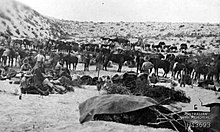8th Light Horse Regiment (Australia)
| 8th Light Horse Regiment | |
|---|---|
First World War
| |
| Insignia | |
| Unit colour patch |  |
The 8th Light Horse Regiment was a
Formation

The 8th Light Horse Regiment was raised at
All
Operational history

Gallipoli
In December 1914, the 8th Light Horse Regiment left Sydney for Egypt, arriving on the 1 February 1915.
Sinai and Palestine Campaign

On their arrival back in Egypt, the 3rd Light Horse Brigade was assigned to the newly raised
With the
The war in the Middle East ended shortly afterwards when the armistice of Mudros was signed in October 1918. Afterwards, the regiment returned to Egypt to assist in putting down a revolt, before sailing for Australia in July 1919. The war cost the regiment almost 200 per cent casualties, 302 killed and 675 wounded.[1]
Perpetuation
In 1921, the decision was made to perpetuate the honours and traditions of the AIF by reorganising the units of the
The unit remained on the order of battle throughout the inter-war years, and upon the outbreak of the Second World War, the regiment formed part of the
The regiment was mobilised for war service and deployed to the Northern Territory to bolster the garrison there. It was eventually gazetted as an AIF unit in 1943, meaning that it could serve in an operational capacity outside of Australian territory if required,[10] but was eventually deemed surplus to requirements as the Australian Army was partially demobilised in the later war years, and was disbanded in March 1944 at Watsonia, Victoria.[9][12] In the post war period, the regiment was re-raised as an amalgamated unit, designated the 8th/13th Victorian Mounted Rifles, which remained in existence until 1991–92.[13]
Commanding officers
The following officers commanded the 8th Light Horse during the First World War:[1]
- Lieutenant Colonel Alexander Henry White (KIA)
- Lieutenant Colonel Arthur Vivian Deeble
- Lieutenant Colonel VD
- Lieutenant Colonel Archibald McGibbon McLaurin
- Lieutenant Colonel Herbert James Shannon DSO
Battle honours
For its involvement in the First World War, the 8th Light Horse was awarded the following battle honours:
- Palestine 1917–1918.[1]
References
- Citations
- ^ a b c d e f g h i j k l m "8th Light Horse Regiment". First World War, 1914–1918 units. Australian War Memorial. Retrieved 29 November 2011.
- ^ Gullet 1941, p. 54.
- ^ Horner and Williams, Chapter: Setting up the Light Horse
- ^ Gullett 1941, p. 29.
- ^ Gullett 1941, p. 38.
- ^ "Lieutenant Colonel Alexander Henry White, MID". Australian War Memorial. Retrieved 17 December 2011.
- ISBN 9780522842364.
- ^ Grey 2008, p. 125.
- ^ a b Festberg 1972, p. 44.
- ^ a b Finlayson 2012, p. 199.
- ^ Handel 2003, p. 148.
- ^ "8 Light Horse: History". Orders of Battle. Archived from the original on 17 October 2014. Retrieved 11 October 2014.
- ^ Finlayson 2012, p. 323.
- Bibliography
- Festberg, Alfred (1972). The Lineage of the Australian Army. Melbourne, Victoria: Allara Publishing. ISBN 978-0-85887-024-6.
- Finlayson, David (2012). Green Fields Beyond. Canberra, Australian Capital Territory: Department of Veterans' Affairs. OCLC 799180097.
- ISBN 9780521697910.
- OCLC 220901683.
- Handel, Paul (2003). Dust, Sand & Jungle: A History of Australian Armour During Training and Operations, 1927–1948. Puckapunyal, Victoria: RAAC Memorial and Army Tank Museum. ISBN 1-876439-75-0.
- ISBN 978-1-74246-894-5.
Further reading
- ISBN 978-0-7336-2272-4.)
{{cite book}}: CS1 maint: location missing publisher (link - Simpson, Cameron (1998). Maygar's Boys: A Biographical History of the 8th Light Horse Regiment AIF 1914–19. Moorooduc, Victoria: Just Soldiers, Military Research and Publications. ISBN 9780646325248.
